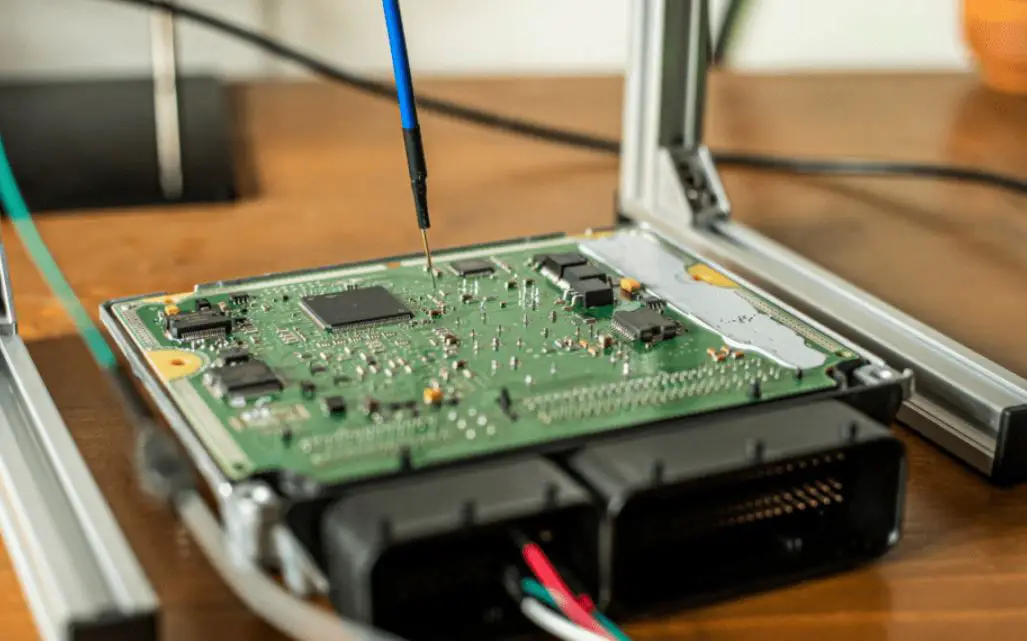The ECU or engine control unit controls most aspects of your car’s smooth running. These could result in your ignition failing or a complete decline in engine performance. You should test your ECU if you suspect a problem to learn more about what is happening. How, then, do you test an ECU with a multimeter?
When you connect your multimeter to the circuit, 50 amps of full-scale deflection will be applied to load and test the circuit. Indicating if you have a faulty circuit or component, this measurement—which often reads more than 1.2 amps—will be given to you.

What Is an ECU?
The engine control unit is known as ECU. It is the component of your vehicle that manages the engine. Your automobile will not operate very well if it fails. It could run very slowly, or it might not run at all.
It is equipped with microprocessors, allowing it to process the data coming in from the engine sensors. Both hardware—made of electronic fittings mounted on a ceramic substrate or circuit board—and software elements are used to accomplish this.
The microcontroller chip, which houses most of the software and permits reprogramming through uploading new codes, is a key component of this circuit board.
ECUs come in both analog and digital varieties.
Whereas digital ECUs employ microprocessors to regulate current flow, analog ECUs use a mixture of capacitors and resistors. Consult the service handbook for your car or get in touch with the manufacturer if you are unsure about the sort of ECU you have.
To guarantee that your ECU functions without a hitch, you may connect a multimeter to test the reading and make sure that the necessary amount of power is being supplied.
Having trouble using a multimeter? There is no issue. We will guide you through each stage of the procedure.
What is a Multimeter?
Multimeters are essential equipment for testing electrical systems. They are used in electrical circuits to measure voltage, current, and resistance and are available in some forms.
Yet, not all multimeters are made the same. To test ECUs, you must be sure to use the appropriate one.
Using a multimeter to Test the ECU
You should make various preparations before testing your ECU with a multimeter. First, ensure the battery in your automobile supplies the circuits with adequate voltage.
Ensure you have the appropriate equipment. A multimeter and some fundamental knowledge are required to test an ECU. To reduce the danger of electrocution, always unplug the battery before starting any operation.
Verify that the automobile is parked on a level surface and that no one might be hurt if anything goes wrong if they were nearby. The last thing you would like to do is harm the ECU or other surrounding components, so take your time and be patient.
Step 1
It is now time to configure the Multimeter for this test. The red line should be connected to the volt, amp, and ohms indicator jack, and the black lead should be connected to the COM connector.
Step 2
The current checking point should be selected using the Multimeter’s wheel selection. First, visually inspect the ECU to ensure all connections, cables, and plugs are secure and that its surrounding components do not have any obvious damage before doing this test.
Step 3
It is necessary to recognize the pins connected to the ground and electricity. It is as simple as connecting the leads and checking your readings after sorting them out.
Step 4
Your ECU is probably in excellent shape if all readings are within specifications. But, if you see any aberrant results beyond 1.2 amps, it indicates something is amiss, and you should take additional action.
Symptoms of a Faulty ECU
And what happens if the ECU fails? Of course, the most apparent issue is that the automobile will not start, but that is not the only issue that could arise.
The ECU’s failure might seriously harm the car’s other components.
The fuel pump may cease functioning due to a defective or malfunctioning ECU, impairing the car’s ability to distribute gasoline efficiently. Moreover, this implies that the combustion process cannot occur, which may cause misfiring and a loss of power.
Your ECU likely must be changed if you exhibit any of the symptoms listed below.
- Starting the engine is difficult or impossible.
- The engine is making loud, irregular noises.
- The vehicle is not accelerating correctly.
- Poor braking is present in the vehicle.
- On the dashboard, there are caution lights.
- There is an engine overheat.
Would you Reset the ECU After Battery Disconnection?
The ECU is often reset by unplugging the battery. Does it, however, really function?
According to the automobile, obviously. Disconnecting the battery might have more negative effects than positive effects in certain cars since they contain memories that save information like the last time the engine was started.
On the other hand, if you unplug the battery, certain vehicles will reset. Hence, before tinkering with the wiring, you must understand what type of automobile you are working with.
The easiest approach to find out whether this will benefit you is to examine your owner’s handbook to see if it has any particular instructions for the make and model of your car so you can quickly reset the ECU.
Conclusion
The procedure of using a multimeter to test an ECU might be intimidating. Yet, if you stick to these straightforward instructions, it will not be too challenging for you to swiftly and simply test your ECU. This will enable you to confirm the accuracy of the reading and further identify your issue.
When you test your ECU, if the measurement is less than 1.2 amps and there is no obvious damage to the device, the issue is probably in another place.

